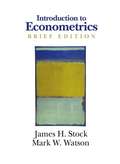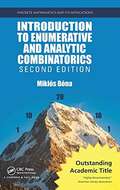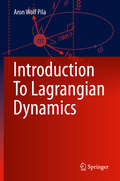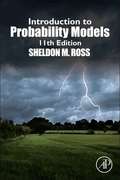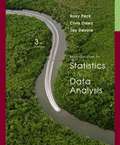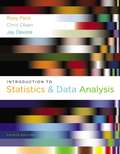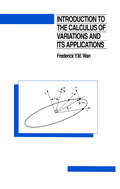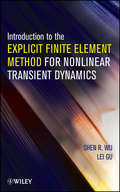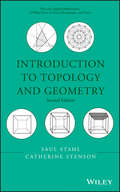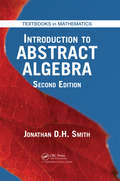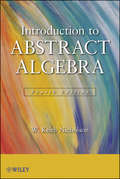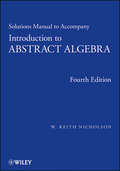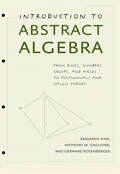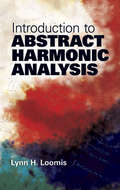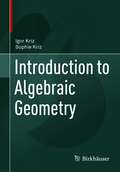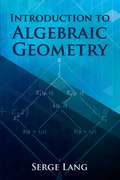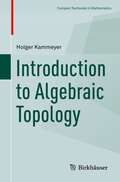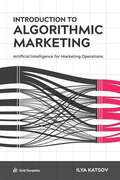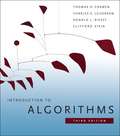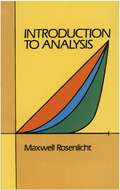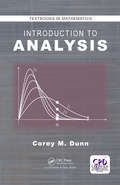- Table View
- List View
Introduction To Econometrics (Brief Edition)
by James H. Stock Mark W. WatsonIn keeping with their successful introductory econometrics text, Stock and Watson motivate each methodological topic with a real-world policy application that uses data, so that readers apply the theory immediately. Introduction to Econometrics, Brief, is a streamlined version of their text, including the fundamental topics, an early review of statistics and probability, the core material of regression with cross-sectional data, and a capstone chapter on conducting empirical analysis. Introduction and Review: Economic Questions and Data; Review of Probability; Review of Statistics. Fundamentals of Regression Analysis: Linear Regression with One Regressor; Regression with a Single Regressor: Hypothesis Tests and Confidence Intervals in the Single-Regressor Model; Linear Regression with Multiple Regressors; Hypothesis Tests and Confidence Intervals in the Multiple Regressor Model; Nonlinear Regression Functions; Assessing Studies Based on Multiple Regression; Conducting a Regression Study Using Economic Data. MARKET: For all readers interested in econometrics.
Introduction To Enumerative And Analytic Combinatorics (Discrete Mathematics And Its Applications Ser.)
by Miklos BonaIntroduction to Enumerative and Analytic Combinatorics fills the gap between introductory texts in discrete mathematics and advanced graduate texts in enumerative combinatorics. The book first deals with basic counting principles, compositions and partitions, and generating functions. It then focuses on the structure of permutations, graph enumeration, and extremal combinatorics. Lastly, the text discusses supplemental topics, including error-correcting codes, properties of sequences, and magic squares. Strengthening the analytic flavor of the book, this Second Edition: * Features a new chapter on analytic combinatorics and new sections on advanced applications of generating functions * Demonstrates powerful techniques that do not require the residue theorem or complex integration * Adds new exercises to all chapters, significantly extending coverage of the given topics Introduction to Enumerative and Analytic Combinatorics, Second Edition makes combinatorics more accessible, increasing interest in this rapidly expanding field.
Introduction To Lagrangian Dynamics
by Aron Wolf PilaThis volume provides a short summary of the essentials of Lagrangian dynamics for practicing engineers and students of physics and engineering. It examines a range of phenomena and techniques in a style that is compact and succinct, while remaining comprehensive. The book provides a review of classical mechanics and coverage of critical topics including holonomic and non-holonomic systems, virtual work, the principle of d’Alembert for dynamical systems, the mathematics of conservative forces, the extended Hamilton’s principle, Lagrange’s equations and Lagrangian dynamics, a systematic procedure for generalized forces, quasi-coordinates, and quasi-velocities, Lagrangian dynamics with quasi-coordinates, Professor Ranjan Vepa’s approach and the Hamiltonian formulation. Adopting a step-by-step approach with examples throughout the book, this ready reference completely develops all of the relevant equations and is ideal for practicing mechanical, aeronautical, and civil engineers, physicists, and graduate/upper-level undergraduate students.Explains in detail the development of the theory behind Lagrangian dynamics in a practical fashion;Discusses virtual work, generalized forces, conservative forces, constraints, Extended Hamilton’s Principle and the Hamiltonian formulation;Presents two different approaches to the quasi-velocity method for non-holonomic constraints;Reinforces concepts presented with illustrative examples;Includes comprehensive coverage of the important topics of classical mechanics.
Introduction To Linear Algebra: Computation, Application, and Theory (Textbooks in Mathematics)
by Mark J. DeBonisIntroduction to Linear Algebra: Computation, Application, and Theory is designed for students who have never been exposed to the topics in a linear algebra course. The text is filled with interesting and diverse application sections but is also a theoretical text which aims to train students to do succinct computation in a knowledgeable way. After completing the course with this text, the student will not only know the best and shortest way to do linear algebraic computations but will also know why such computations are both effective and successful. Features: Includes cutting edge applications in machine learning and data analytics Suitable as a primary text for undergraduates studying linear algebra Requires very little in the way of pre-requisites
Introduction To Linear Optimization
by Dimitris Bertsimas John N. TsitsiklisThe purpose of this book is to provide a unified, insightful, and modern treatment of linear optimization, that is, linear programming, network flow problems, and discrete linear optimization.
Introduction To Probability Models
by Sheldon M. RossIntroduction to Probability Models, Tenth Edition, provides an introduction to elementary probability theory and stochastic processes. There are two approaches to the study of probability theory. One is heuristic and nonrigorous, and attempts to develop in students an intuitive feel for the subject that enables him or her to think probabilistically. The other approach attempts a rigorous development of probability by using the tools of measure theory. The first approach is employed in this text. The book begins by introducing basic concepts of probability theory, such as the random variable, conditional probability, and conditional expectation. This is followed by discussions of stochastic processes, including Markov chains and Poison processes. The remaining chapters cover queuing, reliability theory, Brownian motion, and simulation. Many examples are worked out throughout the text, along with exercises to be solved by students. This book will be particularly useful to those interested in learning how probability theory can be applied to the study of phenomena in fields such as engineering, computer science, management science, the physical and social sciences, and operations research. Ideally, this text would be used in a one-year course in probability models, or a one-semester course in introductory probability theory or a course in elementary stochastic processes.
Introduction To Statisitcs and Data Analysis
by Roxy Peck Chris Olsen Jay DevoreNIMAC-sourced textbook
Introduction To Statistics And Data Analysis
by Roxy Peck Chris Olsen Jay DevoreRoxy Peck, Chris Olsen, and Jay Devore's new edition uses real data and attention-grabbing examples to introduce students to the study of statistics and data analysis. Traditional in structure yet modern in approach, this text guides students through an intuition-based learning process that stresses interpretation and communication of statistical information. Simple notation--including the frequent substitution of words for symbols--helps students grasp concepts and cement their comprehension. Hands-on activities and interactive applets allow students to practice statistics firsthand. INTRODUCTION TO STATISTICS AND DATA ANALYSIS, 4th Edition, includes updated coverage of the graphing calculator as well as expanded coverage of probability.
Introduction To Statistics: An Intuitive Guide For Analyzing Data And Unlocking Discoveries
by Jim FrostBuild a solid foundation in data analysis. Be confident that you understand what your data are telling you and that you can explain the results to others! I'll help you intuitively understand statistics by using simple language and deemphasizing formulas. This guide starts with an overview of statistics and why it is so important. We proceed to essential statistical skills and knowledge about different types of data, relationships, and distributions. Then we move to using inferential statistics to expand human knowledge, how it fits into the scientific method, and how to design and critique experiments.
Introduction To The Calculus of Variations And Its Applications
by Frederic WanThis comprehensive text provides all information necessary for an introductory course on the calculus of variations and optimal control theory. Following a thorough discussion of the basic problem, including sufficient conditions for optimality, the theory and techniques are extended to problems with a free end point, a free boundary, auxiliary and inequality constraints, leading to a study of optimal control theory.
Introduction To The Explicit Finite Element Method For Nonlinear Transient Dynamics
by Shen R. Wu Lei GuA systematic introduction to the theories and formulations of the explicit finite element method As numerical technology continues to grow and evolve with industrial applications, understanding the explicit finite element method has become increasingly important, particularly in the areas of crashworthiness, metal forming, and impact engineering. Introduction to the Explicit Finite Element Method for Nonlinear Transient Dynamics is the first book to address specifically what is now accepted as the most successful numerical tool for nonlinear transient dynamics. The book aids readers in mastering the explicit finite element method and programming code without requiring extensive background knowledge of the general finite element. The authors present topics relating to the variational principle, numerical procedure, mechanical formulation, and fundamental achievements of the convergence theory. In addition, key topics and techniques are provided in four clearly organized sections: * Fundamentals explores a framework of the explicit finite element method for nonlinear transient dynamics and highlights achievements related to the convergence theory * Element Technology discusses four-node, three-node, eight-node, and two-node element theories * Material Models outlines models of plasticity and other nonlinear materials as well as the mechanics model of ductile damage * Contact and Constraint Conditions covers subjects related to three-dimensional surface contact, with examples solved analytically, as well as discussions on kinematic constraint conditions Throughout the book, vivid figures illustrate the ideas and key features of the explicit finite element method. Examples clearly present results, featuring both theoretical assessments and industrial applications. Introduction to the Explicit Finite Element Method for Nonlinear Transient Dynamics is an ideal book for both engineers who require more theoretical discussions and for theoreticians searching for interesting and challenging research topics. The book also serves as an excellent resource for courses on applied mathematics, applied mechanics, and numerical methods at the graduate level.
Introduction To Topology And Geometry
by Saul Stahl Catherine StensonAn easily accessible introduction to over three centuries of innovations in geometry Praise for the First Edition ". . . a welcome alternative to compartmentalized treatments bound to the old thinking. This clearly written, well-illustrated book supplies sufficient background to be self-contained. " --CHOICE This fully revised new edition offers the most comprehensive coverage of modern geometry currently available at an introductory level. The book strikes a welcome balance between academic rigor and accessibility, providing a complete and cohesive picture of the science with an unparalleled range of topics. Illustrating modern mathematical topics, Introduction to Topology and Geometry, Second Edition discusses introductory topology, algebraic topology, knot theory, the geometry of surfaces, Riemann geometries, fundamental groups, and differential geometry, which opens the doors to a wealth of applications. With its logical, yet flexible, organization, the Second Edition: * Explores historical notes interspersed throughout the exposition to provide readers with a feel for how the mathematical disciplines and theorems came into being * Provides exercises ranging from routine to challenging, allowing readers at varying levels of study to master the concepts and methods * Bridges seemingly disparate topics by creating thoughtful and logical connections * Contains coverage on the elements of polytope theory, which acquaints readers with an exposition of modern theory Introduction to Topology and Geometry, Second Edition is an excellent introductory text for topology and geometry courses at the upper-undergraduate level. In addition, the book serves as an ideal reference for professionals interested in gaining a deeper understanding of the topic.
Introduction to Abstract Algebra (Textbooks In Mathematics Ser.)
by Jonathan D. SmithIntroduction to Abstract Algebra, Second Edition presents abstract algebra as the main tool underlying discrete mathematics and the digital world. It avoids the usual groups first/rings first dilemma by introducing semigroups and monoids, the multiplicative structures of rings, along with groups.This new edition of a widely adopted textbook covers
Introduction to Abstract Algebra (The\prindle, Weber And Schmidt Series In Mathematics)
by W. Keith NicholsonPraise for the Third Edition ". . . an expository masterpiece of the highest didactic value that has gained additional attractivity through the various improvements . . ."—Zentralblatt MATH The Fourth Edition of Introduction to Abstract Algebra continues to provide an accessible approach to the basic structures of abstract algebra: groups, rings, and fields. The book's unique presentation helps readers advance to abstract theory by presenting concrete examples of induction, number theory, integers modulo n, and permutations before the abstract structures are defined. Readers can immediately begin to perform computations using abstract concepts that are developed in greater detail later in the text. The Fourth Edition features important concepts as well as specialized topics, including: The treatment of nilpotent groups, including the Frattini and Fitting subgroups Symmetric polynomials The proof of the fundamental theorem of algebra using symmetric polynomials The proof of Wedderburn's theorem on finite division rings The proof of the Wedderburn-Artin theorem Throughout the book, worked examples and real-world problems illustrate concepts and their applications, facilitating a complete understanding for readers regardless of their background in mathematics. A wealth of computational and theoretical exercises, ranging from basic to complex, allows readers to test their comprehension of the material. In addition, detailed historical notes and biographies of mathematicians provide context for and illuminate the discussion of key topics. A solutions manual is also available for readers who would like access to partial solutions to the book's exercises. Introduction to Abstract Algebra, Fourth Edition is an excellent book for courses on the topic at the upper-undergraduate and beginning-graduate levels. The book also serves as a valuable reference and self-study tool for practitioners in the fields of engineering, computer science, and applied mathematics.
Introduction to Abstract Algebra, Solutions Manual
by W. Keith NicholsonPraise for the Third Edition". . . an expository masterpiece of the highest didactic value that has gained additional attractivity through the various improvements . . ."--Zentralblatt MATHThe Fourth Edition of Introduction to Abstract Algebra continues to provide an accessible approach to the basic structures of abstract algebra: groups, rings, and fields. The book's unique presentation helps readers advance to abstract theory by presenting concrete examples of induction, number theory, integers modulo n, and permutations before the abstract structures are defined. Readers can immediately begin to perform computations using abstract concepts that are developed in greater detail later in the text.The Fourth Edition features important concepts as well as specialized topics, including:The treatment of nilpotent groups, including the Frattini and Fitting subgroupsSymmetric polynomialsThe proof of the fundamental theorem of algebra using symmetric polynomialsThe proof of Wedderburn's theorem on finite division ringsThe proof of the Wedderburn-Artin theoremThroughout the book, worked examples and real-world problems illustrate concepts and their applications, facilitating a complete understanding for readers regardless of their background in mathematics. A wealth of computational and theoretical exercises, ranging from basic to complex, allows readers to test their comprehension of the material. In addition, detailed historical notes and biographies of mathematicians provide context for and illuminate the discussion of key topics. A solutions manual is also available for readers who would like access to partial solutions to the book's exercises.Introduction to Abstract Algebra, Fourth Edition is an excellent book for courses on the topic at the upper-undergraduate and beginning-graduate levels. The book also serves as a valuable reference and self-study tool for practitioners in the fields of engineering, computer science, and applied mathematics.
Introduction to Abstract Algebra, Third Edition
by T.A. WhitelawThe first and second editions of this successful textbook have been highly praised for their lucid and detailed coverage of abstract algebra. In this third edition, the author has carefully revised and extended his treatment, particularly the material on rings and fields, to provide an even more satisfying first course in abstract algebra.
Introduction to Abstract Algebra: From Rings, Numbers, Groups, and Fields to Polynomials and Galois Theory
by Benjamin Fine Gerhard Rosenberger Anthony M. GaglioneA new approach to abstract algebra that eases student anxieties by building on fundamentals.Introduction to Abstract Algebra presents a breakthrough approach to teaching one of math's most intimidating concepts. Avoiding the pitfalls common in the standard textbooks, Benjamin Fine, Anthony M. Gaglione, and Gerhard Rosenberger set a pace that allows beginner-level students to follow the progression from familiar topics such as rings, numbers, and groups to more difficult concepts. Classroom tested and revised until students achieved consistent, positive results, this textbook is designed to keep students focused as they learn complex topics. Fine, Gaglione, and Rosenberger's clear explanations prevent students from getting lost as they move deeper and deeper into areas such as abelian groups, fields, and Galois theory. This textbook will help bring about the day when abstract algebra no longer creates intense anxiety but instead challenges students to fully grasp the meaning and power of the approach. Topics covered include:• Rings• Integral domains• The fundamental theorem of arithmetic• Fields• Groups• Lagrange's theorem• Isomorphism theorems for groups• Fundamental theorem of finite abelian groups• The simplicity of An for n5• Sylow theorems• The Jordan-Hölder theorem• Ring isomorphism theorems• Euclidean domains• Principal ideal domains• The fundamental theorem of algebra• Vector spaces• Algebras• Field extensions: algebraic and transcendental• The fundamental theorem of Galois theory• The insolvability of the quintic
Introduction to Abstract Harmonic Analysis: University Series In Higher Mathematics (Dover Books on Mathematics)
by Lynn H. LoomisThis classic monograph is the work of a prominent contributor to the field of harmonic analysis. Geared toward advanced undergraduates and graduate students, it focuses on methods related to Gelfand's theory of Banach algebra. Prerequisites include a knowledge of the concepts of elementary modern algebra and of metric space topology.The first three chapters feature concise, self-contained treatments of measure theory, general topology, and Banach space theory that will assist students in their grasp of subsequent material. An in-depth exposition of Banach algebra follows, along with examinations of the Haar integral and the deduction of the standard theory of harmonic analysis on locally compact Abelian groups and compact groups. Additional topics include positive definite functions and the generalized Plancherel theorem, the Wiener Tauberian theorem and the Pontriagin duality theorem, representation theory, and the theory of almost periodic functions.
Introduction to Algebraic Geometry
by Igor Kriz Sophie KrizThe goal of this book is to provide an introduction to algebraic geometry accessible to students. Starting from solutions of polynomial equations, modern tools of the subject soon appear, motivated by how they improve our understanding of geometrical concepts. In many places, analogies and differences with related mathematical areas are explained. The text approaches foundations of algebraic geometry in a complete and self-contained way, also covering the underlying algebra. The last two chapters include a comprehensive treatment of cohomology and discuss some of its applications in algebraic geometry.
Introduction to Algebraic Geometry: Interscience Tracts In Pure And Applied Mathematics, No. 5 (Dover Books on Mathematics)
by Serge LangAuthor Serge Lang defines algebraic geometry as the study of systems of algebraic equations in several variables and of the structure that one can give to the solutions of such equations. The study can be carried out in four ways: analytical, topological, algebraico-geometric, and arithmetic. This volume offers a rapid, concise, and self-contained introductory approach to the algebraic aspects of the third method, the algebraico-geometric. The treatment assumes only familiarity with elementary algebra up to the level of Galois theory.Starting with an opening chapter on the general theory of places, the author advances to examinations of algebraic varieties, the absolute theory of varieties, and products, projections, and correspondences. Subsequent chapters explore normal varieties, divisors and linear systems, differential forms, the theory of simple points, and algebraic groups, concluding with a focus on the Riemann-Roch theorem. All the theorems of a general nature related to the foundations of the theory of algebraic groups are featured.
Introduction to Algebraic Topology (Compact Textbooks in Mathematics)
by Holger KammeyerThis textbook provides a succinct introduction to algebraic topology. It follows a modern categorical approach from the beginning and gives ample motivation throughout so that students will find this an ideal first encounter to the field. Topics are treated in a self-contained manner, making this a convenient resource for instructors searching for a comprehensive overview of the area.It begins with an outline of category theory, establishing the concepts of functors, natural transformations, adjunction, limits, and colimits. As a first application, van Kampen's theorem is proven in the groupoid version. Following this, an excursion to cofibrations and homotopy pushouts yields an alternative formulation of the theorem that puts the computation of fundamental groups of attaching spaces on firm ground. Simplicial homology is then defined, motivating the Eilenberg-Steenrod axioms, and the simplicial approximation theorem is proven. After verifying the axioms for singular homology, various versions of the Mayer-Vietoris sequence are derived and it is shown that homotopy classes of self-maps of spheres are classified by degree.The final chapter discusses cellular homology of CW complexes, culminating in the uniqueness theorem for ordinary homology.Introduction to Algebraic Topology is suitable for a single-semester graduate course on algebraic topology. It can also be used for self-study, with numerous examples, exercises, and motivating remarks included.
Introduction to Algorithmic Marketing: Artificial Intelligence for Marketing Operations
by Ilya KatsovIntroduction to Algorithmic Marketing is a comprehensive guide to advanced marketing automation for marketing strategists, data scientists, product managers, and software engineers. It summarizes various techniques tested by major technology, advertising, and retail companies, and it glues these methods together with economic theory and machine learning. The book covers the main areas of marketing that require programmatic micro-decisioning - targeted promotions and advertisements, eCommerce search, recommendations, pricing, and assortment optimization.
Introduction to Algorithms
by Clifford Stein Thomas H. Cormen Charles E. Leiserson Ronald L. RivestSome books on algorithms are rigorous but incomplete; others cover masses of material but lack rigor. Introduction to Algorithms uniquely combines rigor and comprehensiveness. The book covers a broad range of algorithms in depth, yet makes their design and analysis accessible to all levels of readers. Each chapter is relatively self-contained and can be used as a unit of study. The algorithms are described in English and in a pseudocode designed to be readable by anyone who has done a little programming. The explanations have been kept elementary without sacrificing depth of coverage or mathematical rigor.
Introduction to Analysis
by Maxwell RosenlichtWritten for junior and senior undergraduates, this remarkably clear and accessible treatment covers set theory, the real number system, metric spaces, continuous functions, Riemann integration, multiple integrals, and more. Rigorous and carefully presented, the text assumes a year of calculus and features problems at the end of each chapter. 1968 edition.
Introduction to Analysis (Textbooks in Mathematics)
by Corey M. DunnIntroduction to Analysis is an ideal text for a one semester course on analysis. The book covers standard material on the real numbers, sequences, continuity, differentiation, and series, and includes an introduction to proof. The author has endeavored to write this book entirely from the student’s perspective: there is enough rigor to challenge even the best students in the class, but also enough explanation and detail to meet the needs of a struggling student. From the Author to the student: "I vividly recall sitting in an Analysis class and asking myself, ‘What is all of this for?’ or ‘I don’t have any idea what’s going on.’ This book is designed to help the student who finds themselves asking the same sorts of questions, but will also challenge the brightest students." Chapter 1 is a basic introduction to logic and proofs. Informal summaries of the idea of proof provided before each result, and before a solution to a practice problem. Every chapter begins with a short summary, followed by a brief abstract of each section. Each section ends with a concise and referenced summary of the material which is designed to give the student a "big picture" idea of each section. There is a brief and non-technical summary of the goals of a proof or solution for each of the results and practice problems in this book, which are clearly marked as "Idea of proof," or as "Methodology", followed by a clearly marked formal proof or solution. Many references to previous definitions and results. A "Troubleshooting Guide" appears at the end of each chapter that answers common questions.
